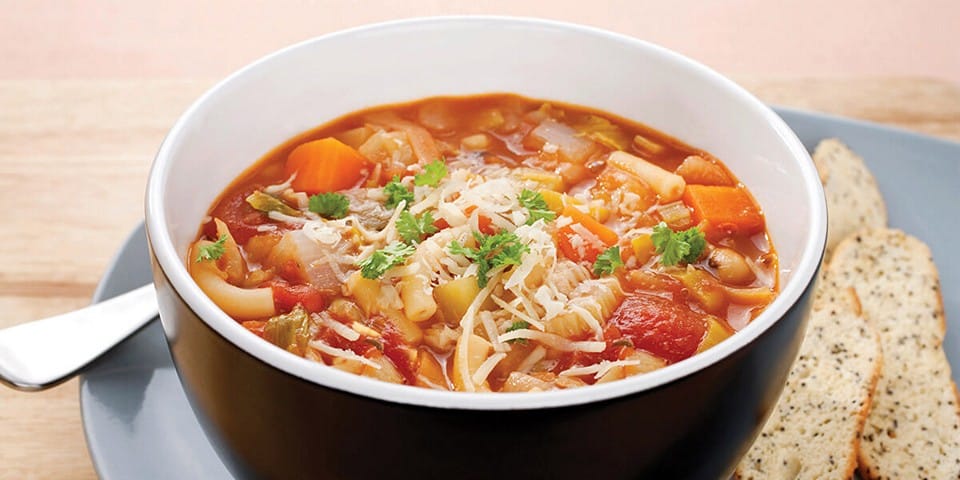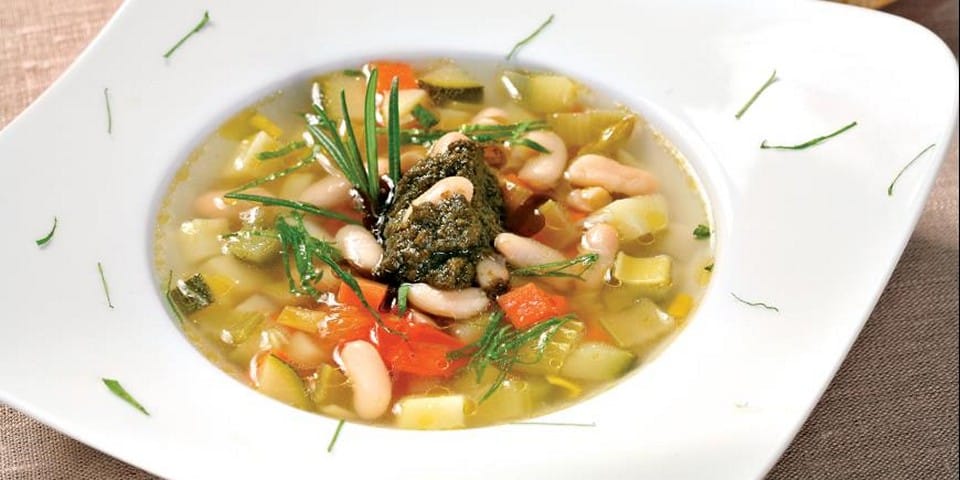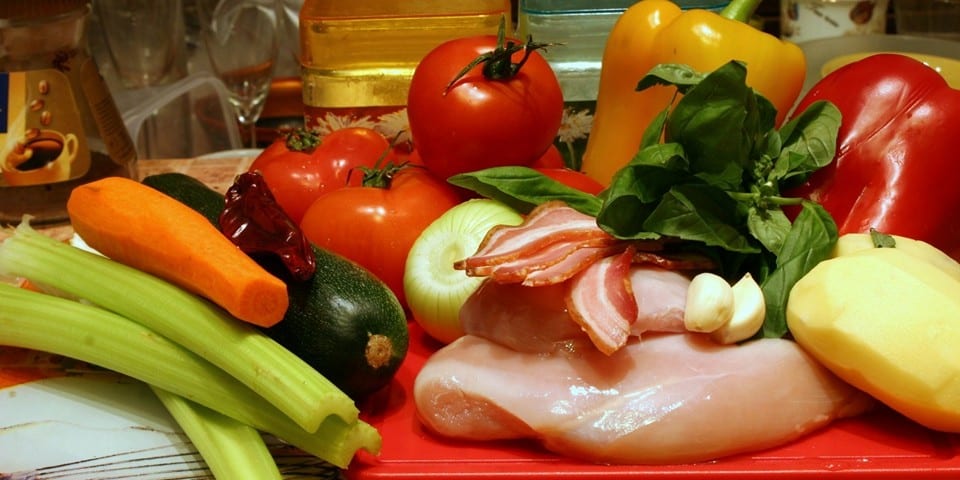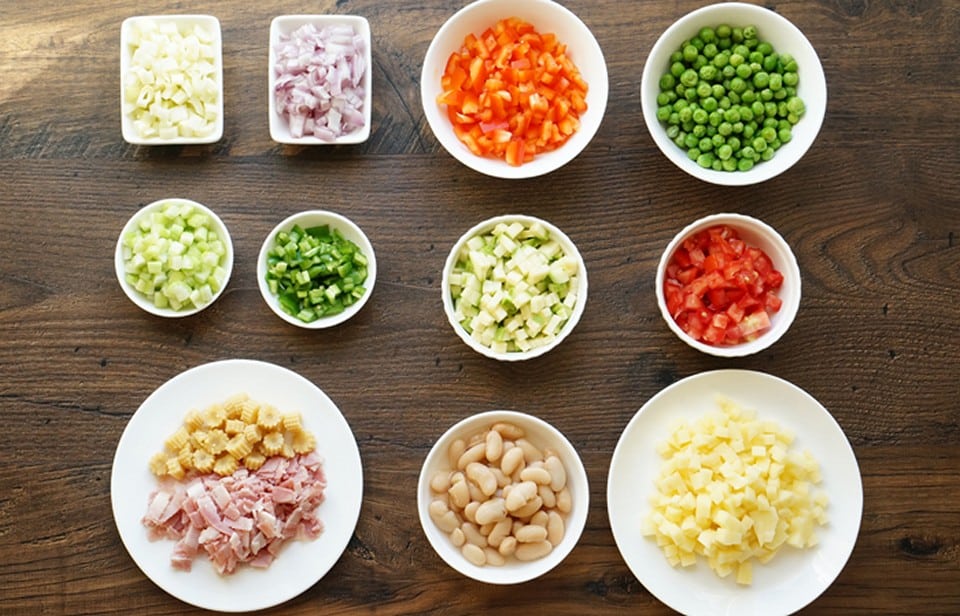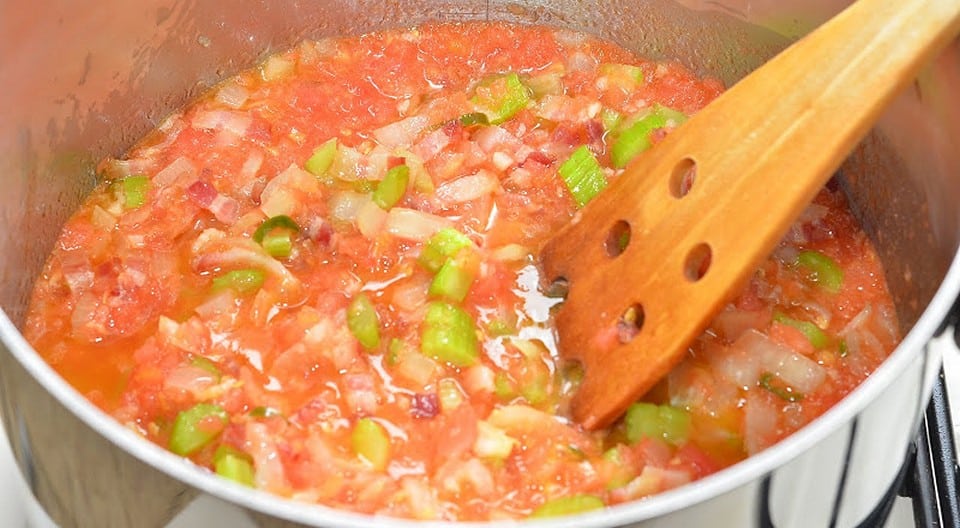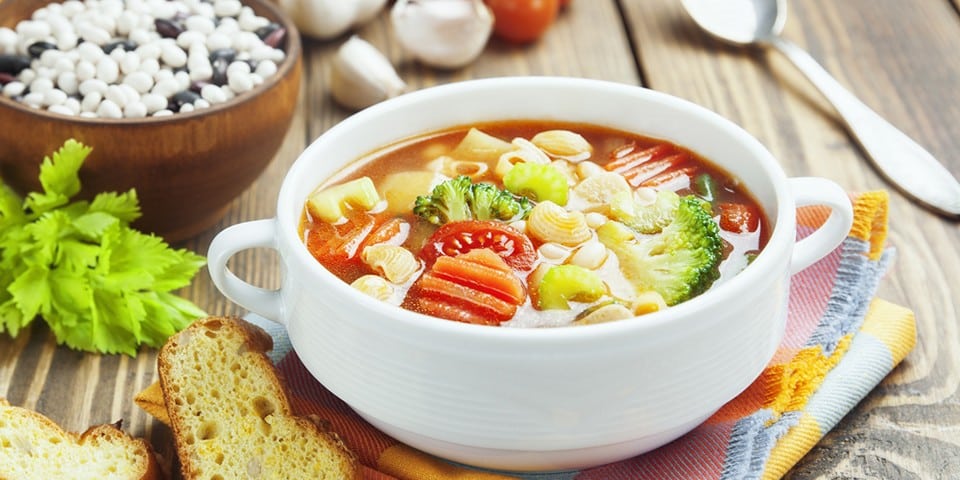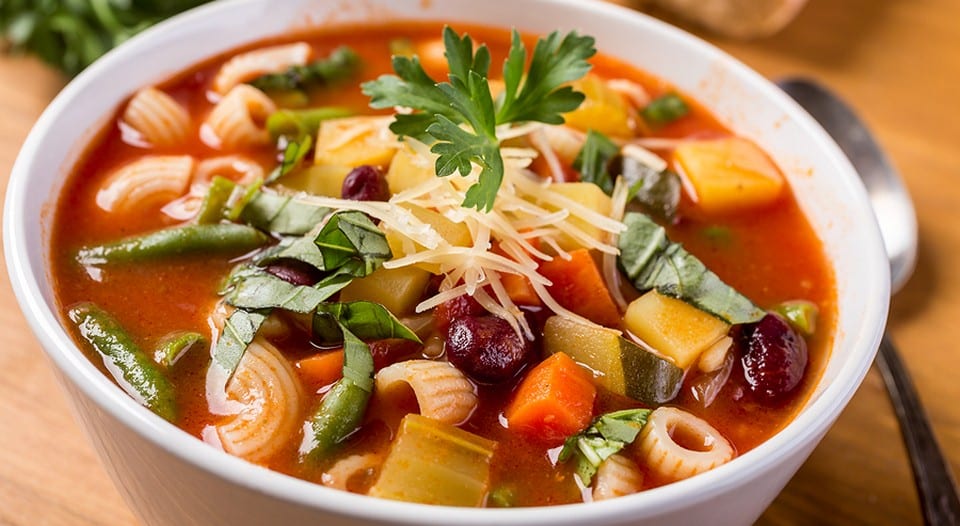Minestrone is the most popular soup originating from Italy. It is so strongly associated with Italian cuisine that when people mention “Italian soup” outside the country, they undoubtedly mean minestrone. Its base consists of broth, vegetables, and legumes. Italians prepare it using seasonal ingredients, but it is also permissible to use frozen peas or beans.
The health benefits of the ingredients make minestrone a highly nutritious dish. It is more than just a soup; it represents the principles of Italian eating. If you want to learn about its origins and how to prepare a classic minestrone in your own kitchen, then welcome to the article.
Page Contents
Origin and Variations
Minestrone has a very ancient origin. Even in the Roman Empire, a vegetable soup was prepared using ingredients such as onions, garlic, carrots, asparagus, lentils, and mushrooms. Additional ingredients were added over the centuries due to new discoveries. For example, potatoes and tomatoes became part of the dish when they “arrived” in Italy after the discovery of America in the 16th century.
Originally, minestrone was a humble soup primarily made from leftovers or the cheapest vegetables. It was everyday food, not a dish reserved for weddings or festive occasions.
The absence of a strict recipe for the soup in modern times can be explained by the fact that the ingredients were never pre-determined. In other words, if a person bought chicken to later fry and eat it, minestrone was prepared differently. The components used were whatever was available in the house.
Between the 17th and 18th centuries, Italian chefs popularized the dish beyond the borders of the republic. However, even today, the soup is perceived as a tribute to peasant tradition.
Its name literally translates to “that which is served” (as food). The first recorded use of the term “Minestrone” for a vegetable soup dates back to the 18th and 19th centuries.
The recipe for Minestrone can vary depending on the region where it is prepared. The term “Classic Minestrone” (Minestrone classico) is somewhat relative as there is no consensus among chefs regarding its exact composition. However, certain key ingredients are strictly regulated, including broth, beans, onions, celery, carrots, and tomatoes. Some traditionalists argue against the inclusion of “non-European” vegetables such as tomatoes and potatoes in the dish.
Some prefer to cook Minestrone with water, while others opt for meat-based broths. Some add pasta, while others prefer rice. Its consistency can range from thick and hearty, resembling a ragù, to very liquid. For example, the classic version tends to have more broth compared to the Genoese-style Minestrone (Minestrone alla genovese), which also incorporates Pesto sauce into its ingredients.
In recent times, the word “minestrone” has actually become synonymous with the phrase “mix everything.” However, modern chefs do not use leftovers from previous meals but rather acquire fresh vegetables in advance when planning to prepare the soup. Nowadays, minestrone is enjoyed not as a main dish but as a light first course that sets the tone for a satisfying lunch.
A Classic Recipe for Minestrone
The classic recipe for minestrone is present in every region of Italy. However, there are no significant differences; only some ingredients vary. We suggest preparing the most popular winter version of this dish in our republic. Considering the peculiarities of our climate, it is best for home cooks to create this delicacy in the second half of summer.
So, here’s what we’ll need:
- Water – 700 ml (2.96 cups)
- Cauliflower – 400 g (14.11 oz)
- Tomatoes – 350 g (12.35 oz)
- Potatoes – 330 g (11.64 oz)
- Pumpkin – 250 g (8.82 oz)
- Fresh beans – 200 g (7.05 oz)
- Fresh or frozen green peas – 200 g (7.05 oz)
- Leeks – 150 g (5.29 oz)
- Smoked pancetta – 110 g (3.88 oz)
- Zucchini – 100 g (3.53 oz)
- Onion – 80 g (2.82 oz)
- Carrots – 80 g (2.82 oz)
- Celery – 60 g (2.12 oz)
- Olive oil – 60 g (2.12 oz)
- Rosemary – 6 g (0.21 oz)
- Parsley – 5 g (0.18 oz)
- Ground black pepper – 2 g (0.07 oz)
- Garlic – 1 clove
- Bay leaves – 2
- Salt and nutmeg to taste.
Before starting the process, it is necessary to wash and dry all the vegetables. Tie the rosemary and bay leaf together tightly with kitchen twine, ensuring that the herb leaves do not end up in the soup during cooking.
How to Cook Minestrone
Start by peeling the skin off the pumpkin. Use a spoon to remove the seeds and fibrous flesh. Cut the pumpkin and zucchini into cubes. If using fresh beans in pods, shell them and separate the beans.
Separate the cauliflower into florets. Slice the white part of the leek into thin rings, and dice the pancetta.
Peel the potatoes and tomatoes, removing the skin and stem. Cut them into cubes as well. Finely chop the peeled carrots, celery, and onion. Chop the parsley coarsely.
Now that all the ingredients are prepared, you can proceed to the main step. In a pot with a non-stick coating and high sides, heat olive oil and sauté the carrots, onions, and celery for 7-8 minutes. Be careful not to let the vegetables stick to the bottom of the pot.
Add the crushed garlic and diced pancetta without turning off the heat. The pancetta will add flavor to the soup. Also, place the bouquet garni (bundle of herbs) in the pot. Mix the leek rings with a small amount of water (approximately 50 ml) and combine them with the vegetable mixture. Simmer on low heat for about 10 minutes.
Next, add the diced pumpkin and fresh beans to the pot. Cook the dish over medium heat for another 10 minutes, stirring occasionally.
Then, add the potatoes, cauliflower, zucchini, nutmeg, salt, and pepper to the vegetable mixture. Cook the mixture for approximately 5-6 minutes. Add the green peas and tomatoes to the pot, then pour in the remaining water and cover with a lid. Let the minestrone simmer over medium heat for about 30 minutes. Remove the garlic clove and continue cooking for another 15 minutes without removing it from the heat.
A few seconds before removing the pot from the stove, add chopped parsley. Remove the bouquet garni and stir thoroughly to allow the vegetables to absorb each other’s flavors.
If you prefer your soups to be more liquid, you can add some boiling water to it. Your minestrone, following the classic recipe, is ready! In Italy, before serving, minestrone is drizzled with olive oil or sprinkled with grated Parmesan cheese.
Minestrone can be stored in a container with a tightly fitting lid in the refrigerator for up to 3 days. However, like many Italian soups, it reaches its maximum flavor by the second day. If desired, you can extend its shelf life by freezing it.
How to Modify the Recipe
Minestrone is a highly versatile dish. The suggested vegetables can be replaced with ones of your preference, or you can add additional ingredients. For example, broccoli, cabbage, spinach, or mushrooms. The list can go on indefinitely. However, it’s worth noting that Italian chefs never include arugula and Brussels sprouts in the soup as they overpower the flavors of other vegetables. Chicory and artichokes are also not allowed as they introduce unnecessary bitterness.
For those who prefer soups with pasta or rice, you can add the desired component during the cooking process. Make sure to adjust the cooking time of the minestrone accordingly to accommodate the chosen ingredient.
Minestrone with chicken only differs from the classic version by the addition of cubes of the chicken breast during the cooking process. The Genoese version of the soup is enriched with Pesto sauce at the end of the process.
Possible Errors in Preparation
Minestrone is a multi-component soup that allows for creativity. Modern stores are filled with a huge variety of products all year round. Incorrect selection and subsequent processing of ingredients are the main causes of errors in preparing vegetable soup.
To ensure your dish doesn’t become unappetizing and tasteless liquid, remember the following:
- Do not use frozen vegetables. Yes, it’s very convenient and reduces cooking time significantly. However, they negatively affect the taste of the soup. The only exception may be green peas. Using canned legumes is also strictly prohibited.
- Do not add bouillon cubes to minestrone. The aroma of the first course with a bouquet of vegetables does not require additional chemicals. The only acceptable flavor enhancers are herbs (rosemary, sage, bay leaf, thyme, parsley, basil, celery leaves), as well as salt and black ground pepper. The color of the broth can be adjusted with certain ingredients. For example, unpeeled onion gives a golden hue, while tomatoes impart a rich red color.
- Avoid limiting the variety of ingredients. In Italy, the usual practice is to use a maximum number of seasonal vegetables. In autumn, in addition to the standard ingredients, pumpkin, cabbage, and broccoli are also used. Some chefs even add mushrooms.
- The size of the chopped vegetables also matters. Finely chopped vegetables turn minestrone into a puree-like mass. On the other hand, large pieces do not fully absorb the overall flavor of the soup. If beans are included, the rest of the vegetables should be cut to match their size. Otherwise, everything is diced into 1.5 cm cubes.
- The taste of the dish is always enhanced by additional components. These include pasta made from hard wheat varieties, egg noodles, rice, pearl barley, fried bread or croutons, and grated garlic.
Caloric Content and Benefits of Minestrone
Minestrone is considered one of the healthiest soups. It is included in diet menus for weight loss because the caloric content of this classic dish is extremely low, amounting to approximately 39 kcal per 100g.
The nutritional value is distributed as follows:
- Protein – 1.7g;
- Fat – 1.3g;
- Carbohydrates – 5.4g.
Low-sodium soup is excellent for controlling blood pressure levels. Being rich in potassium, it helps diversify the diet of individuals suffering from hypertension.
The high content of dietary fiber is beneficial for treating constipation. This fact also contributes to a prolonged feeling of satiety.
The low glycemic index of minestrone has a positive impact on metabolism and makes the soup beneficial for individuals with diabetes.
Now you know everything about the most popular, beneficial, and simply delicious Italian soup. Live with humor, travel spontaneously, and remember: “There’s nothing better in the world than cooking minestrone in the summer!”
Interesting facts
- Minestrone, a classic Italian soup, dates back to ancient Roman times, making it one of the oldest soup recipes still enjoyed today. Its rich history adds a touch of tradition to every bowl.
- Minestrone is a versatile soup that varies widely across different regions of Italy. Each version reflects the local ingredients and culinary traditions, making it a delightful exploration of Italian flavors.
- Minestrone is a true celebration of seasonal produce. It is typically made with a colorful medley of vegetables, including tomatoes, carrots, zucchini, beans, and leafy greens, ensuring a fresh and vibrant bowl of goodness.
- This hearty soup often features a variety of legumes like kidney beans, chickpeas, or cannellini beans, which provide a protein-rich base and contribute to its satisfying texture.
- One of the secrets to the incredible depth of flavor in Minestrone is the slow cooking process. Simmering the soup for a long time allows the flavors to meld together, creating a comforting and nourishing dish.
- In addition to vegetables and legumes, some regional variations of Minestrone include pasta, rice, or even small dumplings, adding another layer of texture and heartiness to the soup.
- Minestrone is a fantastic dish for those seeking a healthy meal. Packed with fiber, vitamins, and minerals, this soup provides a nourishing and low-calorie option while still keeping your taste buds satisfied.
 Italy for me From Italy with love
Italy for me From Italy with love


